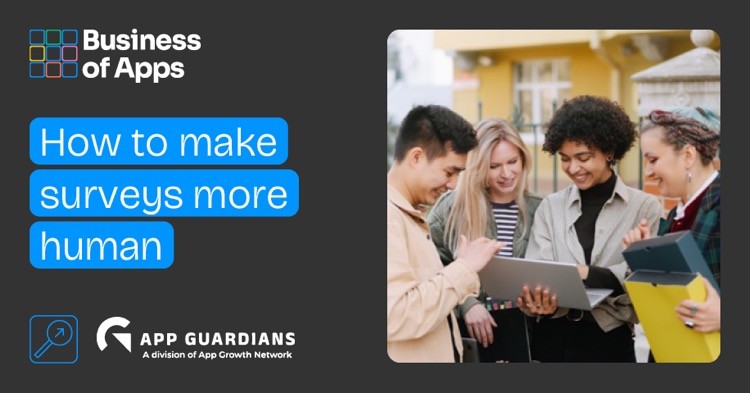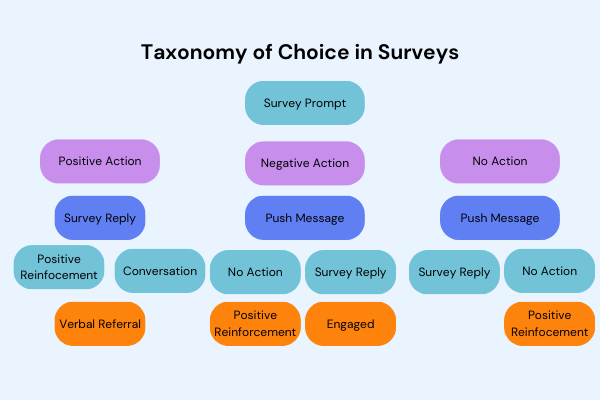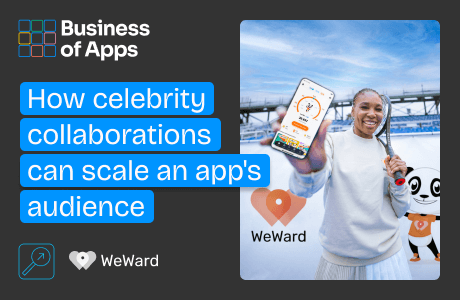For Wellness apps, the most challenging approach is the conversion of the user from passive to active. The ability for a user to engage with the app is inherently more personal than functional: the app itself presents a change to the user’s own life.
Knowing this, app marketers must be aware of how invested the user is to their own life’s health and wellness. With a market share of $5.6 Trillion the wellness industry itself is becoming a self-serve supplement to the government health care system. Users at large are looking for technological solutions to ensure their own habits can change. And in that change, users are looking for the bigger picture: an app that can be their guide, mentor, or coach through this type of psyche change.
The best way to understand the holistic picture is by customer surveys. Surveys represent a standard in what we do, however the approach has been much more passive and causes many users to ignore triggers based on how surveys have been done: in app pops, emails, 5 star ratings.
This is how you will increase survey response and build a strong relationship with each and every user:
First, the reader will be shown unique ways to adapt their quantitative data to include more qualitative data. This is important as not just numerically can we see how the user engages, but the keywords and the way users speak to us in unique surveys can uncover the true value of the app to their daily life.
Second, you will discover how the app needs to function as a parasocial relationship to increase survey results. In adapting behavioral approaches, the app company can become a connection to the user as that guide, mentor, or coach by connecting daily use with a wider community and support network. This will allow for greater value being placed on the app itself, and the user truly defining the app as the habitual exercise that will create that inherent change within themselves. Thus, the request for a survey becomes a conversation. It becomes an organic action that the user will be inclined to engage in because they are in the relationship, and thus want that relationship to improve.
Behavioral economics and user engagement
Wellness is all about nudging. Part of the main goal when setting up the taxonomy, is to create a healthy user journey that encourages positive daily habits. As any wellness app it always starts with an idea, and a lot of app developers tend to be focused on how the app should work. What’s missing is the key factor in all of this – not everyone will be the same. Wellness apps need to focus on breaking bad habits. Noom, for example, does this in a gentle, gamified way that is unique to the user based on several quantitative metrics. However, the app itself presents a more organic entity dialogue. The no-judgment, pragmatic encouragement that is offered gives way to a user wanting to go on the app just to check how they’re doing and being given that extra encouragement that may not be in their lives.
This is of the utmost importance: if you don’t take psyche and internal dialogue into how the user engages with the app, then you create a cold function. The user will never want to engage.
As this agency worked through several wellness apps, we realized that the key differentiator to any other industry is the impact on the person. The app isn’t simply creating a habit; it’s changing the human at their core. When the user starts looking for any wellness app, the key motivator is always about change. Change in humans has always been a point of contention. We like habits, we want to maintain comfort. When our perceived hierarchy of needs are met, we don’t necessarily have a reason for that change. From our clients 10% Happier, Breethe, Day One, to Better Sleep, we see users wanting to engage in a way that is more organic than functional. Retention becomes hard when the support circle, or perceived support circle, isn’t there.
Maximize App Growth with #1 App Store Optimization Company
Expand app store reach, increase downloads, boost engagement, lower acquisition costs & achieve higher user LTV with our leading ASO services & technology
Contact Us TodayWhat we can do when adapting behavior economics within survey attribution is actually make the app into a living entity. It no longer serves a purpose but has a purpose. When the app is like that best friend or voice in the user’s head, it makes a dialogue where we can encourage those good habits. When we then apply this to surveying our customers, we make it more likely for the user to engage if they feel like they are playing an essential and active role, not just clicking a star rating.
Methodology of customer surveying
Sure, we have rating surveys and 5-star choices, but there is a huge level of surveying that app marketing just doesn’t do. However, when you approach the app from a more behavioral mindset, you can gather real-time data outside of MMP and numerical evaluations to truly understand the nature of the relationship the user has.
When our team looks at the standard benchmarks, and you can read about that here, we use several ways to measure. We all know the standard MMP platforms; however, this only offers an “if this than that ” analysis and doesn’t take into account the relationship the user has with the app in a very human way. One click equals one action. However, outside that click we lose the understanding of the intrinsic value the app has to the user. A click doesn’t denote the emotion or need of the user at the time.
Your methodology needs to build upon three key features—basic principles. However, you will go one step further in applying the knowledge from our clients to provide a solid case for adopting these approaches. We need to use what we know, but incorporate an extra thought into that very human user who sees the company as more than just a tool.
Framing survey questions
With generic framing, the greatest issue is disengagement. It’s far easier for a user to click out of a pop up or survey because they can absolutely recognize the questions are canned.
Framing techniques to help present survey questions should be done from the perspective of a friend asking another for help. For instance, framing questions positively, “How has using our wellness app improved your daily routine?” may seem appropriate, but it’s also not genuine. Linguistic patterns are evident when it comes to tech engagement. The way our team would have approached it may have been, “Have you found (insert function) really changed your routine?” Building honesty into it using the term elicits that facade of humanity behind the prompt.
Creating 5 questions with space to answer (either in voice or text) makes the data more accessible to you and the engagement more appealing to the user. You want to get to the point where when the app asks, the user always answers.
Choice architecture
Bottom line: Don’t make the survey mechanical.
The user’s parasocial relationship with the app should dictate how the choices and interactions play out. Yes, sometimes you can’t avoid multiple-choice questions. However, if you prioritize the questions in the way you would want to have a conversation with a user, you create a more organic feel that will allow more users to want to engage.
In taxonomy, we know how the flow should start and end. However, to understand the user’s connection within the survey, it’s the in-between that counts. Think of it in terms of a conversation: when you ask a friend about a new “thing” how does that pattern evolve? While we can adapt specific machine learning protocols to help evolve this conversation through mechanics, we still need the choices to appear earnest. For some, machine learning or AI plug-ins may not be financially feasible.
Most surveys want to be neat, without space for the user to write their own reply – however, in some cases, we need to anticipate the response from the user in their own vernacular. With a current journaling app client, the prompts and push notifications were written from a voice very well-researched. The co-founders, both distinguished researchers in psychology, wanted to build the app so it was almost human. Limited by some resources, they did this in the copy. Taking the extra care to think about how they would say it, versus what is standard makes the app engagement intimate. The app itself is intimately connected to the user. Any less care and it would not have the impact. Each prompt was built on the notion of “how would I say this to my friend?” From there, the user flow was defined by that very real conversational flow.
Building the choices in terms of true-to-life-speech is part of the solution. App survey responses tend to do better when the option is more aligned with how the user speaks. If they can see themselves in the answer, the survey will prove more impactful for the developer.
Loss aversion
We all want to share FOMO and leverage this tactic to get someone to engage more. However, users are becoming more desensitized to the many prompts offered by their mobile apps, terms and conditions, and more. Whether it’s a push notification about missing out on a 15% sale or an app prompt saying “we miss you” to try to encourage more action, most wording and expectations are low for users.
Loss aversion needs to be ordered to allow the user to see, from a pull strategy, that they are indeed building with the app developer team. When the user feels part of the entire community that creates change – something that Gen Z is highly keen on – the user will want to be part of it every day.
Creating a deficiency in messaging should be applied by offering the user a chair at the table. For example “Rate this App!” is a popular one-click prompt already at the center of debate since 2019. This Harvard Business Review article explains well how the 5-star rating system is not only broken for platforms themselves, but users just don’t trust them or want to participate. The same still holds in 2024, as users are more aware of bots, false reviews, and bought fake profiles. Building something that works means also considering meeting users where they are and, yes, offering the user to be more of a “consultant” than “consumer feedback”.
For example, “Do you like us?” could be reframed to “What’s the most frustrating part of working with (app name)?”. It’s negative, but it also allows self-awareness and the ability to know the limitations of our development.
Qualitative data is the most important. When you can create a cross-reference chart to see key emotional values in the words people use or the stories they share, you can enlist the same tone to personalize truly. In some cases, as AI gets more integrated with our development systems, we can personalize based on these parameters for a real-time individualization of the app experience.
When we apply this with overall quantitative benchmarks, we can now draw the user’s holistic human value with the app.
Quantitative results and behavioral considerations
The unit economics will further create a more definitive picture of the survey journey you want the user to complete. Given the state of integration with all points of attribution, when running an ongoing customer survey, you need to treat engagement as important as the app itself. User feedback campaigns should be on par with user retention yet approached like user acquisition. You are, after all, acquiring the user again to move through this action.
While unit economics provides a clear financial picture, KPIs encompass a broader range of metrics. To truly understand how users interact with your mobile app, customer surveys become even more powerful when analyzed alongside user behavior data. This combined approach allows you to map the user journey in greater detail.
By layering in app usage information, you can pinpoint specific stages where users encounter friction. Surveys strategically placed at these points can then gather valuable feedback on user sentiment and identify areas for improvement.
You can also quantify user engagement with features and content through surveys. This data, when combined with metrics like frequency of use and session length, helps assess if features are truly valuable or hindering the user journey. By integrating these behavioral insights into KPIs, you gain a deeper understanding of how users interact with your app.
This can lead to improvements in conversion rates by revealing reasons behind user hesitation during signup. Similarly, you can identify reasons for churn through surveys and user behavior data, allowing you to address issues like lack of perceived value or technical problems.
Ultimately, customer satisfaction surveys directly measure user sentiment, and user behavior data can reinforce or contradict this feedback. This combined approach provides a powerful lens for understanding customer journeys and optimizing KPIs. By identifying pain points, measuring engagement, and directly gauging user satisfaction, you can create a more intuitive and valuable app experience.
Positive impact of wellness app surveys on human psyche
Through various mechanisms, wellness apps have significantly positively impacted the human psyche. These mechanisms still need to be evolved to adapt to a more humanistic relationship. Currently, users see the app as a function of their daily routine. As stated above, when the user feels more of a relationship with the app, in a way they would check in with a friend daily, that parasocial dialogue is more accessible to encourage good habits and positive corporate goals for the user, the company, and the community. Likewise, the survey has to represent that check-in. A cadence that makes sense with the actions, functions, and daily habits must be created to create the survey as part of the overall action of the app.
The following outlines the impact apps can have:
Empowerment and Autonomy
Beyond function is the ability to create a positive space of encouragement and support. When coupled with community engagement or that parasocial relationship with the app itself, wellness apps can become an integral part of the user’s health-healing journey.
We are, after all, building that positive echo chamber for the app ecosystem. One app that does this well and is getting ready to do better is HumanStreams. The gentle approach and the engagement therein allow the user to feel like they are in a unique world all to themselves. The app gives space for meditation, journaling, and a truly personalized relationship with the app.
In the survey portion, building not only timed engagement but positive reinforcement for the user increases the likelihood of repeat survey responses. As stated above, if the user feels part of the ecosystem, then they are made to feel like change is truly happening—a common concern most people have now.
Behavioral activation
Outside of just the key points, reframing beliefs or statements also helps to build that relationship. When you can reframe a thought or an action prompt several ways, you create an indirect new decision each time. No one truly likes seeing “Would you like to save your progress?” even when they leave the app. Instead, attempt to add new ways to say things, new prompts, and new pops almost every week. Much like how humans learn and reframe conversations they may have had before, this becomes more fluid and exciting, even indirectly.
When considering the taxonomy of the app, consider how the survey will work within the daily habit. Creating triggers that ask specific questions after the behavior or within 24 hours keeps the user working through the study daily. A single question, leaving space for open answers, or recognizing a rage click based on known functional limitations and prompting a pop-up or email that is worded kindly, such as “I’m sorry this happened, what can I do better next time?” makes a tertiary touchpoint that will give you better data from the user than a standardized developer report.
Social support and connection
For whatever reason, app companies still lack the ability to build community. Community engagement and that connection between users are going to be even more key in wellness apps. The community is what will drive more fanatics to the brand. When we’re looking at stars, companies like Open or Peloton are at the center. Again, this takes time and work, but the community aspect builds an acquisition network stronger than any paid campaign can give.
When you give that space and support for users to share, even create offline aspects of the app, you make a more robust business ecosystem to proliferate. Regardless of having implementation now or in two years, the plan and strategy must explicitly exist to grow.
Offering a test group or unique community dedicated to improving the app may sound like just one more task many developers don’t want to do. But users are the most honest with troubleshooting in Reddit forums and social conversations. When you can have a dedicated platform or third-party place where users can describe how they are using the app, the real sentiment is revealed around how the app adapts to the human themselves.
Incorporating insights from behavioral economics theories into the methodology of customer surveying enables a deeper understanding of user engagement in wellness apps.
By framing survey questions, designing choice architectures, and leveraging principles such as loss aversion, app developers can glean invaluable insights into user behavior and preferences. Moreover, wellness apps’ positive impacts on the human psyche underscore their potential as powerful tools for promoting mental health and well-being in an increasingly digital world.
Through a synergistic approach that integrates behavioral economics and user-centered design, wellness apps can continue to evolve as catalysts for positive behavior change and psychological flourishing when the user defines themselves as part of the app’s relationship to them. This in turn will provide deeper insight when conducting and creating survey architecture.













